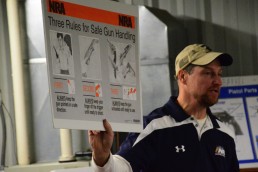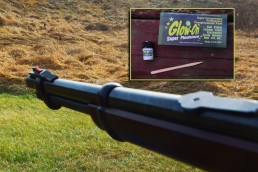Getting Ready for Concealed Carry
SHARE THIS POST
Shoot ‘n’ Plink author Dan Galusha talks concealed carry courses
I’ve been asked several times about practicing for Concealed Carry Weapon (CCW) shooting qualification. Actual shooting is required in 24 states and the District of Columbia to test the ability of people to safely and accurately fire their weapons. The question that I’ve had the most is what a person can shoot at to practice. In my home state of Illinois, you have a big B27 silhouette target. You must hit the middle, qualifying area with at least 70 percent of your rounds and score 105 points. You fire 10 rounds, each, at 5, 7 and 10 yards.
Practicing isn’t all that difficult. Some have said if you can hit a 9-inch paper plate you will qualify. True, but another way to get the feel of shooting the B27 is with a free, miniature B27 you can download from targets4free.com. This prints on a single sheet of regular paper. To save ink, use the draft setting on the printer as there is a lot of black area. If you can place your shots within the 10- x 8-inch miniature silhouette, you should easily qualify when faced with the 45- x 20-inch B27. I suggest trying to hit the center area, up to the 9 ring (approximately 3 x 4 inches). If you can do this, you will ace the shooting portion with a perfect, 150-point score. I did this with my Browning 1911.
Points for plinks
Many folks want to know about the scoring for concealed carry. It’s simple. Four rings, X-center, 10, 9 and 8, score 5 points for every hit. The shots fired into the 7-ring count as 4 points each. Everything else within the silhouette counts as 3 points each. This is both a way to practice and a fun way to get out and shoot targets. Have a competition with friends, or compete against yourself and best your own score. The more shooting and practice that you get in, the better you will do.
Don’t sweat it. Unless you absolutely have never fired a gun and couldn’t hit the side of a barn, then you should be able to do this. Just don’t get overconfident. As with everything, stay serious, focused and safe.
What to expect
Other questions about the concealed carry weapon course concern what the course is like. That varies from state to state, so, again, I’ll use Illinois as an example. I’m sure it is somewhat similar to others, just a bit longer than some.
In most states, veterans get some sort of a break. In Illinois, the full course is 16 hours. Veterans only have to attend the second 8-hour day, which covers all of the laws and when shooting qualification takes place.
To get a feel for the entire course, I sat in for a short time during the first day of the classes conducted by Mark Millichamp in Sherrard, Ill., even though, as a veteran, I only had to attend the second day. Mark is a great instructor, and I could see right off the bat that he had the control and respect of his students. He is an NRA instructor and a former member of the military police. He and his wife Karen are also cowboy competition shooters. So, I had a good teacher for my qualification, as well as for getting an idea of the whole course.
Are you enjoying this post?
You can be among the first to get the latest info on where to go, what to use and how to use it!
Day one
During the first day, the students learned about safely handling their weapons and how to fire them. Among other things, they learned about ammunition, and the correct type to use. This was not just about the semi-automatic pistols that most consider a “carry gun,” but also revolvers in single and double action, both with a hammer and hammerless. Whatever needed to be taught about a handgun was disseminated in this part of the course. A 50-question exam was given at the end.
Day two
The following day was about state laws. This was also when some fellow veterans and I took the course and did our shooting qualification. Mark said it would get boring as he had to read the laws as the state had them written. However, it wasn’t as boring as one might think. Mark did an excellent job of explaining what he read to us, and took questions and comments along the way. At the end, with some members of the class, he did a few re-enactments of situations that could happen. When anyone in the class thought it might be time to use force they would yell, “stop.”At that point, Mark would ask why, and what should or shouldn’t be done. That drove home a lot of points.
Intimidation-free education for all
One woman in the class attended with her husband. This was great, but a lot of women feel intimidated by going into a class full of men. That’s why Mark is setting up Women Only classes. These, also, will be conducted in the Sherrard, Ill. area.
As a last resort only.
At this time, I want to preach a little about something that we learned. Something that responsible gun owners should already know. A Concealed Carry Weapon permit is not a permit to use the weapon offensively. It is a permit for responsible citizens to use a gun for defense only. Your weapon is your last line of defense to protect you and others. People shouldn’t know that you are carrying your weapon. In other words, don’t be flashing it around.
If you would like to take a course for the Illinois CCW permit (recognized in 27 states), whether open or women only, and are interested in Mark’s teachings, call him at 309-235-9619 or email him at uguns65@gmail.com.
No matter which state you are in, I recommend that anyone wanting to take a CCW course ask around. Find a well-qualified person for all aspects of the course—especially the firearms instruction and shooting qualification portions. Even if you don’t want the CCW, I still recommend that firearms newcomers take an NRA firearms handling course. It makes shooting safer for everyone and target shooting and plinking more fun.
For more on concealed carrying, check out this exclusive MidWest Outdoors article.
Did you enjoy this post?
You can be among the first to get the latest info on where to go, what to use and how to use it!
Dan Galusha
Dan Galusha has fished all of his life, worked more than 45 years in the outdoor/media industry, and was inducted into the Fresh Water Fishing Hall of Fame as a Legendary Communicator. Direct questions through dansfishntales.com, facebook.com/dansfishntales and facebook.com/shootnplink.

